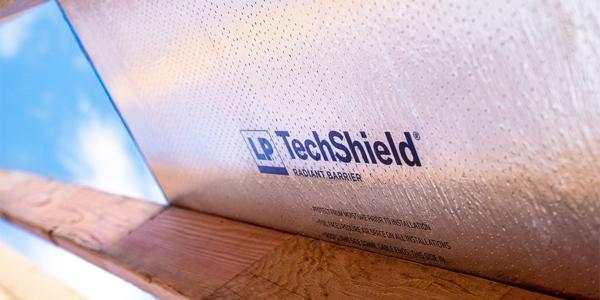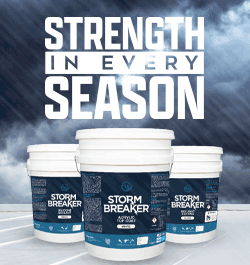What are Radiant Barriers and How do They Work?

By LP Building Solutions.
The science behind heat transfer in attics and why radiant barriers are so impactful in reducing the temperature of your attic.
Anyone who ever needed to go up to get something out of the attic in the middle of the summer can tell you that there are few places hotter and stuffier on a summer day than the attic. In fact, most attics are insufferable in the summer, which is why attic insulation is recommended across the U.S. It might sound counter-intuitive, but insulation can create a radiant barrier to negotiate the heat. To learn more about this phenomenon, LP Building Solutions turned to Building Scientist Neil Freidberg to explain more.
Freidberg is a Building Science Manager at LP Building Solutions. He graduated with a bachelor’s degree in architectural engineering and joined Owens Corning, where Freidberg says he worked with some of the brightest minds in building science. Today, he is a noted speaker and publisher. As building envelopes and energy efficiency become increasingly important, we appreciate leaning on Freidberg’s vast knowledge.
Three types of heat transfer
Let’s begin with a refresher on the basic laws of physics. Heat is always transferred from a hot to cold area through either conduction, convection or radiation — or a combination of two or more types. As the primary source of most heat transfer, radiation is energy emitted through electromagnetic waves in the area.
Here’s an example of each type of heat transfer to help you understand them more easily:
-
Conduction: Touching the stove and burning your hand
-
Convection: Heat flowing through a material as it moves (such as air)
-
Radiation: Heat from a campfire or bright light bulb
What forms of heat transfer are occurring when an attic heats up on a summer day? Primarily, radiation is what causes warm attic spaces.
How does heat transfer into a house?
Radiant heat is energy, and warmer temperatures have higher levels of energy. “Radiant heat is transformative, always changing from high levels of energy to low levels — it’s never low to high,” Freidberg explains. “High energy is always transferring to low energy.”
Freidberg gives the example of being told to shut the door because you’re letting the air conditioning out of the house. “Actually, hot air is rushing into the conditioned space and warming the inside air.”
Essentially, during the warm months heat is transferred into a house because the house is colder. In the wintertime, heat is trying to escape to the colder outside.
Does heat come down through attics?
A well-built home creates a good building envelope to protect from the elements. One of those elements is heat.
“As an example, let’s say a brick wall is built with an air gap, OSB, insulation and gypsum,” Freidberg says. “The brick absorbs sun and releases the heat through radiation. That radiation gets some convection in the air gap and the heat is transferred into the OSB. If it’s colder, that heat is released into the air gap and pushes air, warming surfaces.”
How much heat is transferred into the home from the attic? The amount depends on the outside and inside conditions. “If you keep your house super cold, heat will want to come in more. If it’s 80 degrees and the home is cooled to 70 degrees, that delta 10 is not much. But if your neighbor has their air conditioning dialed down to 60 degrees, heat wants in there more,” says Freidberg.
Radiant barrier attic insulation: How do you reflect heat in the attic?
A radiant barrier installed in the attic effectively blocks most radiant heat transfer. LP® TechShield® Radiant Barrier helps block up to 97% of the radiant heat transfer from within the panel, cooling attic temperatures up to 30 degrees.
Friedberg explains the process: “Let’s go back to our building example, but now it’s an attic: we have black asphalt shingles, OSB, a large air gap, insulation and a living space under the gypsum. The shingles are absorbing heat through radiation and passing through to the cooler space, which is the attic. Let’s say the air gap and insulation heat to 120 degrees. Adding a radiant barrier in the attic can drop the temperature to 90 degrees.”
“The shiny radiant barrier has a very low radiation rate (or emissivity), and it slows down potential heat for radiant heat. Radiant barriers reduce heat gain by pushing radiant heat back through the shingles and outside,” he adds.
Radiant heat isn’t the only heat transfer in an attic. Anything touching the radiant barrier, such as trusses, becomes a conductive heat surface. “When installation instructions are not closely followed and insulation is allowed to touch the LP TechShield Radiant Barrier, it’s no longer a radiant barrier. Instead, it’s a conductive barrier and pushes heat in a different direction,” says Freidberg.
It seems radiant barriers would help across the entire country, but LP TechShield Radiant Barrier sheathing is recommended for warmer climates primarily.
“In colder climates radiant barriers can cool rapidly at night, which can cause moisture to condense on the shiny surface,” says Freidberg. For this reason, we recommend use of radiant barriers in warmer climates.
How insulation prevents heat transfer
Freidberg explains that without insulation, the heat is transferred to the hard surfaces. “There is radiation and convection in the air gap, and it’s now conducting heat onto the stud and gypsum surfaces.”
One of the ways insulation works to prevent heat transfer is that it breaks down the energy waves. “For example, when radiation hits strands of fiberglass insulation it splits the energy, so radiation passes through, breaking down radiative waves,” Freidberg says.
Adding more insulation will not increase the performance of the insulation. And radiant barriers aren’t considered a replacement for insulation. “The mission is to reduce a heat source to make the building more efficient,” says Freidberg. “Technically speaking, using a radiant barrier makes your insulation a bit more effective.”
Learn more about LP Building Solutions in their RoofersCoffeeShop® Directory or visit lpcorp.com.
Original article source: LP Building Solutions





















Comments
Leave a Reply
Have an account? Login to leave a comment!
Sign In